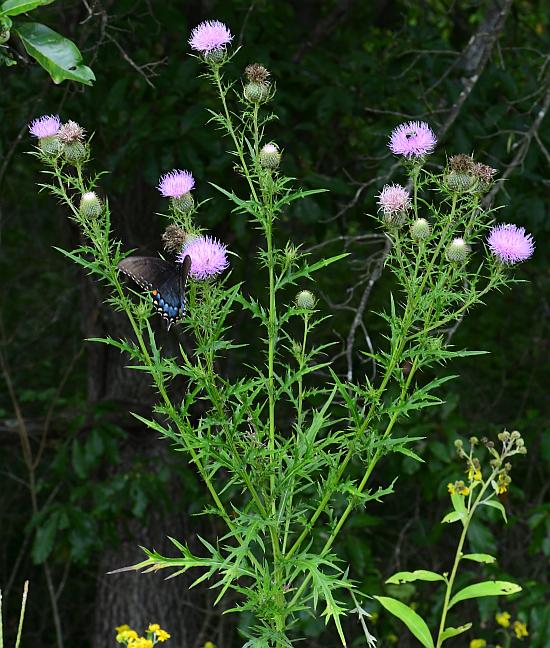Cirsium discolor (Muhl. ex Willd.) Spreng.
Field Thistle

Native
CC = 3
CW = 5
MOC = 48
© SRTurner
Cirsium discolor (Muhl. ex Willd.) Spreng.Field Thistle | |
 |
Native CC = 3 CW = 5 MOC = 48 |
© SRTurner |
|
Family - Asteraceae/Cardueae Habit - Biennial or short-lived perennial forb, often with a slightly thickened taproot in addition to the fibrous roots. Stem - Erect, to 3 m, well branched, glabrous or sparsely pubescent with spreading hairs.
Leaves - Basal and alternate. Basal leaves to 50 cm long, narrowly ovate to elliptic or obovate, deeply lobed, the margins otherwise coarsely toothed and spiny, the upper surface appearing green, pubescent with stiff, straight hairs, the undersurface appearing white, densely pubescent with felty hairs. Stem leaves well developed, the main leaves to 25 cm long, those toward the branch tips usually somewhat reduced, deeply lobed, somewhat clasping and often slightly decurrent at the base, otherwise like the basal leaves.
Inflorescences - Usually solitary heads, terminal on branch tips, nearly sessile, discoid, numerous.
Heads - Discoid, urn shaped, 25-35 mm long, about as long as wide, often somewhat cobwebby-hairy, the lower and median bracts tapered to a spreading, spiny tip, straw-colored to light yellow, usually also somewhat sticky along the midrib.
Florets - Ray florets absent. Disk corollas 25-32 mm long, pinkish, the lobes 6-9 mm long. Pappus of bristles, 18-25 mm long, white or nearly so.
Fruits - To 5.5 mm long, somewhat 4-angled and flattened in cross-section, the tip usually with an angular rim or raised crown surrounding a small, knoblike or conical projection. Flowering - July - November. Habitat - Forest openings, prairies, glades, fields, pastures, roadsides, open disturbed areas. Origin - Native to the U.S. Lookalikes - Other thistles, particularly Cirsium altissimum and C. vulgare. Other info. - This large thistle is most common in the eastern half of the state, and in fact Missouri lies near the western edge of its natural range. Its range in the U.S. includes most of the eastern half of the country, except for portions of the deep south where it is rare or absent. It is characterized by large involucres with spiny bracts and deeply lobed leaves with white undersides. A strongly whitened leaf underside on any Missouri thistle signifies a native species. The coloration is caused by a dense covering of felty hairs.
Photographs taken by DETenaglia; also at Shaw Nature Reserve, Franklin County, MO, 9-1-2008 and 8-28-2021, and West Tyson County Park, St. Louis County, MO, 8-31-2018 and 9-4-2018 (SRTurner). |